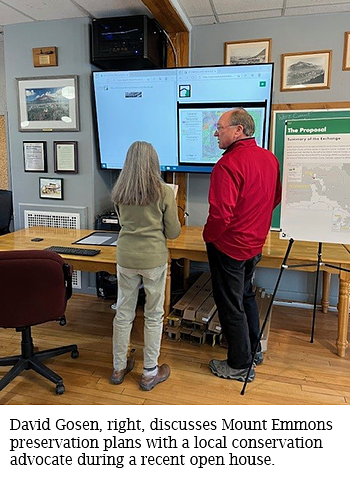 A Colorado mountain known locally as the “Red Lady,” will be protected from future mining, and Mount Emmons Mining Company, a Freeport subsidiary, will gain the ability to manage water treatment and mine reclamation more effectively due to the completion of a complex set of agreements.
A Colorado mountain known locally as the “Red Lady,” will be protected from future mining, and Mount Emmons Mining Company, a Freeport subsidiary, will gain the ability to manage water treatment and mine reclamation more effectively due to the completion of a complex set of agreements.
A federal land exchange, conservation easement and a mineral rights extinguishment effectively end a controversy that began nearly a half century ago between various mining companies, the federal government, local communities and environmental groups.
In completing the land exchange, MEMC receives 539 acres of federal land, which include the former Keystone Mine underground mine workings and the site of an existing water treatment plant, as well as the land upon which tailings storage facilities and retention ponds are located. Under the mineral extinguishment agreement, MEMC voluntarily agreed never to mine the molybdenum deposit at Mount Emmons, thereby protecting the “Red Lady,” named by locals because of its pinkish color.
The final piece of the deal included a conservation easement agreement under which the Crested Butte Land Trust becomes the local steward of those parts of the mountain frequently utilized in the winter by local skiers, thus legalizing access to the top of the Red Lady.
 Water treatment plant integral
Water treatment plant integral
The deal allows the company to operate the water treatment plant without federal approvals associated with conducting work on federal land. The plant cleans the acidic and unsightly orange water discharged from the mine for delivery into adjacent Coal Creek.
Silver, lead and zinc mining in the area began in the 1880s and continued until the 1960s, when the mine and milling operations closed. The molybdenum deposit was discovered in 1977 by Amax, Inc., which applied to the U.S. Forest Service for a permit to mine. That drew immediate opposition from local groups seeking to preserve the mountain.
Amax was required to address impacted water from the old mining operations. The water treatment plant opened in 1982 and remains in operation today under Freeport’s ownership.
Multiple mining companies, including Phelps Dodge Corp., pursued the required federal approvals to mine the molybdenum deposit. All faced stiff community opposition, and none progressed to an operational stage.
 Site obligations managed
Site obligations managed
The project ultimately wound up owned by a company that experienced financial difficulties. Had that company gone bankrupt, responsibility for management of the mining site, including the tailings and water treatment plant, would have defaulted to Freeport as a legacy obligation from its 2007 acquisition of Phelps Dodge. That is what prompted company officials to take ownership in 2016, with the intent of pursuing an agreement that would end the potential for a mine and enable Freeport to more effectively manage its obligations, said Chris Franks, Director-Land Resources.
“We are always encouraged to do the right thing, and this was the right thing,” Franks said. “It takes a company like Freeport with the way that we ethically and responsibly operate our business to pull off a project like this. It actually is a model on how you can conduct business respectfully, with integrity, with excellence and commitment to safety.”
Under the terms of the agreement, MEMC receives 539 acres of federal land where the water treatment plant, tailings and ponds are located. The company voluntarily agreed it would never mine on that property.
Beyond the environmental impacts, the ability to manage the water runoff and operate the treatment plant are vital to Crested Butte, which draws its drinking water supply from Coal Creek just downstream of the Mount Emmons tailings storage facility but upstream of the water treatment plant discharge, said David Gosen, Regional Manager-Remediation Projects, who has spent years helping mitigate impacts from historic mining in the area.
“Our reclamation activities have had a direct, measurable and positive impact on water quality in Coal Creek,” Gosen said. “We have restored areas damaged from past mining activities which has shown positive impacts on Coal Creek. We are designing a new water treatment plant assuring high-quality mine water treatment for decades to come.”
